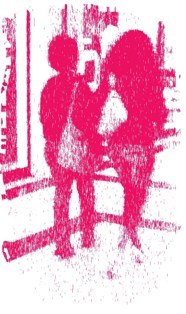
HUMAN TRAFFICKING – MODERN DAY SLAVERY
Trafficking causes unimaginable misery and suffering to those who are dehumanized, forced to become commodities that are bought, sold, used and abused. Reading the definition of trafficking given below will no doubt send shivers down the spines of many readers. What is even more chilling is the fact that trafficking is not very far from our own doors.
A presentation given by Clare Nolan a Good Shepherd Sister identifies the essential evil of trafficking and the individual human response from every person that its very existence cries out for. “What is at stake in the issue of human trafficking is our core spiritual belief that every human person is of infinite worth and dignity, not a commodity to be bought and sold for profit in an underground marketplace. Human trafficking is a grating cry in our time that implicates all of society. Our actions matter as to whether or not we re-claim, as members of our human family, those lost and in bondage to trafficking.”
When referring to the victims of trafficking a recent statement of the Irish Bishops Conference says: “We all have a serious Christian obligation to care for those who have become trapped in this way”. This resource seeks to inform readers and to point to the response that we as people with a mission to love one another and to welcome the stranger in our midst are called on to make. It also points a way for further research into this topic.
DEFINITION: The trafficking of human beings is the recruitment, transportation, transfer, harbouring or receipt of people for the purpose of exploitation. This includes persons forced into prostitution or other forms of sexual exploitation, forced labour or services, slavery or practices similar to slavery, servitude or the removal of organs.
For children exploitation may include also, illicit international adoption, trafficking for early marriage, recruitment as child soldiers, for begging, or for sports (such as child camel jockeys or football players).
Trafficking involves a process of using illicit means such as threat or use of force or other forms of coercion, of abduction, of fraud, of deception, of the abuse of power or of a position of vulnerability.
RESOURCE MATERIAL
Download a ahort overview of trafficking particularly focusing on the trafficking of Women by clicking here here.
Download SMA Justice Briefing 17 “Africa Human Trafficking” by clicking here
 These two resources provide summarised information on:
These two resources provide summarised information on:
• Defining trafficking and the scale of human trafficking in the world.
• The causes of trafficking.
• Trafficking is in Ireland.
• Irish people contribute to the demand that fuels trafficking.
• How trafficking takes place – what happens to victims.
• What the Church says about trafficking.
• Responding to Trafficking and supporting victims.
• Action against Trafficking.
The resource also gives
• Prayer to end Trafficking.
• References to websites for further research and information.
Suggested Method: Over a period of three or four classes;
1. Read and discuss articles.
2. Divide up the points above and allocate to groups to undertake further research – the Newsletter format in which the material was published meant that it had to be brief and in summary form. Extra information and detail can be researched under each of the bullet points above.
3. Ask each group to present their findings to the rest of the class – or to other classes in the school.
4. Discuss and highlight the causes of trafficking, some are obvious others are less so e.g. the demand created by affluence, pornography, the normalisation of the sex industry. Download and use the Power Point slide show “Sex Trafficking Supply and Demand” referred to in the References. Some of this is from a “domestic” US perspective. You may want to delete or edit some of the slides.
5. Discuss responding to trafficking with particular attention to how victims should be viewed, treated and supported. This will also be an opportunity to introduce what the Church says about trafficking and the role that the State and we as individuals have to play in preventing trafficking.
6. Use the “Prayer to end Trafficking” in class or as the basis for drawing up a Prayer Service
Click below to download full text of Newsletter in either pdf or Word format
Trafficking pdf format
